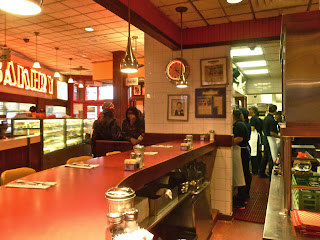On East 59th Street since 1932,
Jim's Shoe Repair is a fourth-generation business. But that's where their long and celebrated history comes to an end. Jim's is being pushed out.

I talked to Joe Rocco, whose grandfather Vito (called Jimmy) opened the shop 82 years ago. Before S.L. Green bought 625 Madison Avenue in 2004, it had been owned by the Ginsberg family for many years. This September, the Roccos' current 10-year lease will come to an end.
"My father went up to ask for an extension," Joe said. "S.L. Green told him no. They already made a deal with Walgreens. They didn't even tell us."
Walgreens plans to expand their giant Duane Reade next door into the cobbler's modest 12-foot-wide space. The Duane Reade already takes up 5,500 square feet, running through the entire block from 58th to 59th Streets. Why do they need 12 more feet of frontage?
The Duane Reade got a 15-year lease extension in 2008. At the time, an executive at Green said, "
We're delighted that Duane Reade will continue its long-term tenancy with us." They should be delighted to have Jim's, a venerable New York City institution.

The shop still looks the way it did decades ago.
It has
antique wooden "while-u-wait" booths, and people still sit inside, waiting for their shoes to be fixed. "Kids come in and think it's a choo-choo train," said Joe, but these are comfortable privacy booths, dating back to a time when people were modest about their stocking feet.
The original 1930s cash register is here, too, a gorgeous heirloom.

The shop enjoys a steady flow of faithful customers, including many well-heeled celebrities, movers, and shakers.
Just last year, Assemblyman Dan Quart presented the senior Mr. Rocco with
a proclamation in honor of his family's long-time service. It states,
“The longevity of this small business is a testament to the quality of its work and broad customer base."
In 1990, at a tough time for the city, Andy Rooney called Jim's a reason to love New York. "Let them knock New York," he wrote. "They don't know Jim's."
Maybe S.L. Green and the people at Walgreens don't know Jim's either. Maybe if they knew, they wouldn't push them out.

Today, everyone who goes to Jim's signs the petition at the counter, under the banner that reads, "Help Us Preserve the Character of NYC." They've got over 2,000 signatures so far, collected in the hopes of holding on to even a fraction of the storefront, just so they can keep on fixing and shining shoes.
"People are heartbroken," said Joe Rocco of his customers. "They're ready to cry when they see we only have eight months left."
A group of lawyers are helping out. "This business is part of the heritage of this neighborhood," said William A. Brewer III, partner at Bickel & Brewer Storefront and counsel to Jim's. "Naturally, we are exploring all of our options--to ensure that this valuable part of our community is not lost.” Brewer continued, "We are grateful for the outpouring of community support, as people rally to defend a business that typifies the American Dream."

Joe's 24-year-old son works in the shop now, extending his great-grandfather's legacy into the fourth generation, a rarity in the city today.
The
oldest business on the block, Jim's is a precious piece of New York's history, a holdout from a time when the streets were full of mom-and-pop businesses, when everybody knew everybody, and each neighborhood had a sense of place. At 625 Madison, they're surrounded by chain stores and global luxury brands.
"What's happening to the city is horrible," said Joe. "There's no character in the neighborhoods anymore. We're losing the history of the city. These places are like a time capsule. If you lose it all, who's going to remember?"
 Post Script:
Post Script: In 2004, S.L. Green bought the building for $231.5 million, or $415/sf. Since then, the value has nearly doubled. In 2013, the ground lease sold to Ashkenazy Acquisition for $400 million, or $710/sf. "Before Ashkenazy pounced," reported the
Post, "there was significant interest from major players, including institutions, real-estate investment trusts, sovereign wealth funds and high-net-worth families." The paper speculated that a super-luxury skyscraper could one day grow on the spot.






















































